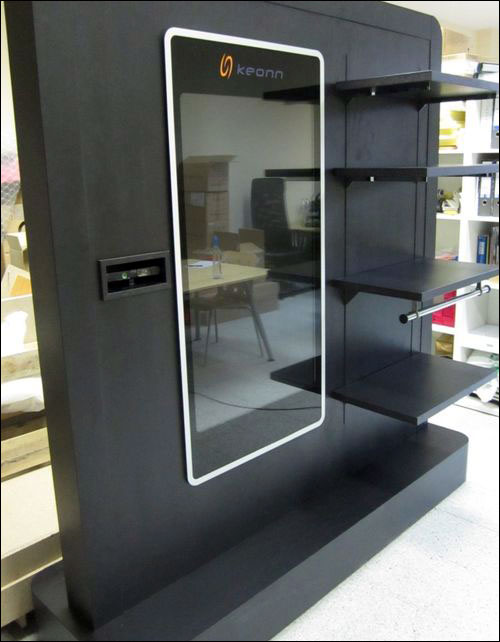A clothing store operated by Roberto Verino, located in Barcelona, Spain, is employing Keonn Technologies‘ AdvanMirror system, enabling customers to view themselves on a video screen as though they were wearing a specific garment, based on the reading of an RFID tag affixed to that piece of clothing. The virtual mirror allows a shopper to sample garments before walking into a fitting room to physically try them on.
The technology is intended not only to provide entertainment and a “wow” factor to the shopping experience, says Ramir De Porrata-Doria, Keonn’s cofounder and CEO, but also to boost sales. The technology utilizes a combination of radio frequency identification and video technologies to enable shoppers to view images of themselves wearing specific clothing items, and forwards that information to an Apple iPad carried by the store’s staff. The salespeople at Roberto Verino can access the iPad to view which items interest a customer, thereby providing the shopper with the opportunity to select other complementary garments or accessories, and to offer them to her as she uses the virtual mirror.
The AdvanMirror is a standalone unit containing four shelves, each featuring a built-in Keonn Technologies RFID reader known as the AdvanReader, and an antenna. The solution includes a camera, a full-length video touch screen (to display images of a person standing before it) and a computer with Keonn software loaded onto it (to link tag ID numbers with images of clothing). The computer uses software from AITech to match a garment’s image with that of the individual using the system, providing the appearance that the shopper is wearing that clothing.
Each article of clothing within the store has an EPC Gen 2 RFID tag attached to it, and the AdvanMirror software stores that tag’s unique ID number, along with a 3-D image of the garment (in other words, multiple images of that item from a variety of angles that can be displayed on the screen to match the individual’s movements). When a shopper places clothing on one of AdvanMirror’s smart shelves, the reader interrogates the item’s tag ID and transmits that information to the built-in computer.
The AdvanMirror’s video camera capture’s the customer’s image in real time, and the AITech software determines that person’s exact position and posture, and displays an image of the garment over her own image. For example, if a customer interested in a blouse raises her arm, the blouse’s sleeve will be raised in conjunction with that movement. If she turns to the side, the garment’s image will do the same, thereby providing a 3-D effect. The shopper can virtually try on several products simultaneously, such as a blouse, a jacket and slacks, all of which would then be displayed on her image as though she is wearing them. In addition, the system overlaps garment images appropriately, such as an open jacket over a blouse.
The technology also works without RFID, De Porrata-Doria says, by requiring a user to scroll through a digital catalog on the screen in order to select apparel that she wishes to view herself wearing. However, he adds, RFID automates that process, by automatically capturing data regarding that garment as its tag comes within read range.
In addition, the software offers the user such functionality as selecting another item that might go well with the garment chosen, simply by using the touch screen. What’s more, each staff member carries an iPad that communicates with the AdvanMirror cloud-based server, enabling that employee to view any clothing that an AdvanMirror user is trying on, and to seek other items that can be suggested to the customer as options.
The system is intended to act as a customer tool, De Porrata-Doria says, but not to replace the use of a fitting room. Instead, it offers additional information, as the customer decides whether to try on a garment. “It’s a kind of filter,” he explains, helping a shopper to narrow down what she likes most and wishes to physically try on. “There’s a role for the seller as well, not just the customer,” he notes, since the AdvanMirror technology allows salespeople to search for items to recommend that could accompany a product being viewed.
The Roberto Verino store added the AdvanMirror solution to an existing RFID system provided by Keonn Technologies. The retailer has also installed reader antennas in the ceiling of its fitting room, to capture the tag ID numbers of any garments taken into the room, and enabling customers to request other items that could accompany the selected clothing. Moreover, the Barcelona store uses an RFID reader at the point of sale (POS) to manage each sales transaction, by simply reading each tag and linking its ID to the POS software. Another interrogator, installed in a mat at the door, reads any tags on garments removed from the store, thereby acting as a theft deterrent.
Keonn Technologies will demonstrate its AdvanMirror system at this year’s RFID Journal LIVE! conference and exhibition, being held in Orlando, Fla., on Apr. 3-5, 2012. The company will display the solution at Booth 1317.


